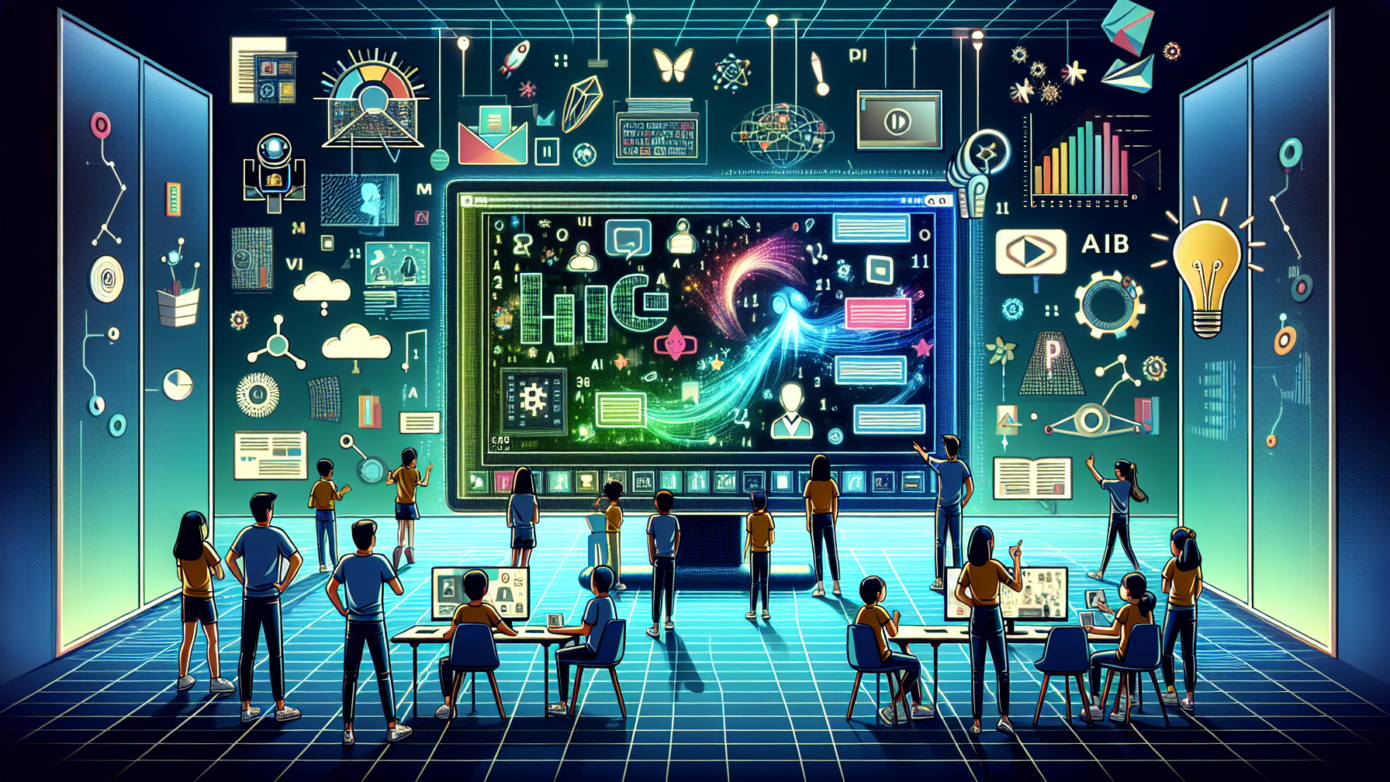Are you a solopreneur looking to enhance your teaching methods? Text to video AI is here to help! This technology turns written content into rich, engaging videos that captivate learners. In fact, studies show visual learning boosts retention rates by 60%.
With tools like Synthesia and Pictory, creating videos is simple and fast. Just write your script, pick visuals, and press generate. Imagine crafting lessons that adapt to different learning styles and support all students, including those with special needs.
In this article, I will share valuable insights about Text to video AI and its benefits in education. Let’s explore how you can transform your lessons and make learning fun!
Understanding Text-to-Video AI in Education
Text-to-Video AI is a cutting-edge technology that converts written texts into dynamic and engaging videos, providing educators with effective tools to enhance learning outcomes. By utilizing platforms such as Synthesia, Pictory, and Lumen5, teachers can transform traditional lesson materials into videos that captively convey information, stimulating creativity and improving comprehension among students.
What is Text-to-Video AI?
Text-to-Video AI fundamentally changes the way content is delivered in classrooms. By converting scripts or written materials directly into videos, these tools break down complex subject matter into digestible visual formats.
Synthesia, for example, utilizes lifelike avatars and customizable backgrounds, allowing educators to create diverse video styles. This is particularly useful in languages and social sciences, where a personal touch in presenting content can enhance relatability.
Pictory and Lumen5 also provide unique features: Pictory excels in summarizing long texts into shorter video snippets, thereby accommodating students’ attention spans. Meanwhile, Lumen5 supports educators in promotional activities, creating visually rich marketing materials for educational content.
Nevertheless, while these platforms have their strengths, they also come with certain challenges. Users may find a learning curve with initial setup and customization options, and potential issues with the accuracy of AI-generated summaries can arise.
How Does Text-to-Video AI Work?
The process of creating videos from scripts through Text-to-Video AI is streamlined and user-friendly. Generally, it involves writing a script, selecting relevant visuals, and generating the final video output. This simplicity allows teachers to concentrate on lesson planning rather than spending excessive time on video production.
At the core of this technology are AI algorithms that integrate Natural Language Processing (NLP) and video synthesis. NLP aids in interpreting the written script, ensuring that the spoken word aligns seamlessly with the visual components chosen. This synergy fosters coherence in the final output, capturing diverse themes in visually and audibly appealing manners.
In educational contexts, this technology not only aids engagement but also makes lessons more memorable. Studies suggest that learners retain up to 60% more when information is delivered through visual means compared to text alone, making Text-to-Video AI an invaluable resource in today’s varied learning landscapes.
Benefits of Text-to-Video AI in Education
Boosting Engagement with Visual Learning
Text-to-Video AI significantly enhances educational engagement by leveraging the power of visual learning. Statistically, it is demonstrated that visual learning can amplify retention rates by around 60% when compared to text alone. This is particularly vital in educational environments where the challenge of maintaining student interest often arises. Educators can adopt various approaches, such as integrating animations or real-life footage, to illustrate complex concepts. For instance, a chemistry teacher could use animated molecular structures to visually represent chemical reactions, making the subject matter not only clearer but also more engaging.
The array of emerging AI tools available further supports these efforts. Among them, tools like Synthesia and Pictory enable users to convert text into dynamic videos effortlessly. On the efficacy scale, platforms like Pictory excel in their simplicity, allowing educators to choose appropriate visuals and emphasize critical lesson points. However, a downside can include potential limitations in the customization of elements, where more advanced features might be locked behind higher payment tiers.
Meeting Different Learning Styles
Recognizing that students possess diverse learning styles—visual, auditory, and kinesthetic, among others—Text-to-Video AI presents an advantageous way to meet these varied needs. This technology empowers educators to create content tailored to different preferences, thereby improving comprehension and retention for all students. For example, a history lesson can be delivered through a vivid video narrative that combines visuals, voiceovers, and music to engage those with auditory learning preferences, while also appealing to visual learners with historical imagery and maps.
Platforms like Lumen5 allow for the easy incorporation of key textual information alongside engaging visuals, catering to multiple learning styles within a single presentation. However, one must weigh the ease of use against the potential for generic outputs—where automated content may lack, at times, a personal touch, making it less relatable for some learners. By understanding the advantages and limitations of these tools, educators can strategize on how best to enhance their lesson delivery and effectively address individual learning needs.
As educational institutions continue to embrace technology, staying up-to-date with the latest industry trends and educational statistics enhances the understanding of how to best leverage Text-to-Video AI. Therefore, employing data-driven strategies ensures that lessons not only remain relevant but also significantly impactful in fostering an engaging learning environment.
Practical Applications of Text-to-Video AI in Education
Creating dynamic and interactive lessons has never been easier with the rise of text-to-video AI tools that support educators in engaging students effectively. These platforms offer streamlined access to visual content, allowing for more varied and immersive learning experiences.
Creating Interactive Lessons
Educators can leverage text-to-video AI to craft lessons that are not only informative but also engaging. The process generally involves three fundamental steps:
- Choose a platform that aligns with your educational goals. Tools like Synthesia provide realistic avatars and customizable backgrounds, making lessons feel more personal and inviting.
- Write a clear and concise script that outlines the lesson objectives and key points. This is essential for ensuring clarity and focus in the generated video.
- Generate the video, incorporating relevant visuals such as animations or curated footage that highlights the key concepts discussed in the script. This multimedia approach increases retention by appealing to various learning styles.
A notable example can be seen in the implementation of Pictory among higher education institutions, where faculty reported a marked increase in student engagement and understanding after utilizing AI-generated videos in their curricula. Learn more here.
Supporting Students with Special Needs
Text-to-video AI can also play a crucial role in accommodating diverse student needs, especially for those with disabilities. The technology provides tailored visual aids that can enhance comprehension and retention.
Benefits of using text-to-video AI include:
- Enhanced accessibility through features like captions, which help hearing-impaired students follow along with the content.
- The inclusion of sign language avatars can aid in communication for students who use sign language as their primary language.
- Adjustable video speeds allow students to learn at their own pace, fostering an inclusive learning environment.
Tools like Lumen5 are particularly effective as they offer user-friendly interfaces that allow educators to quickly add subtitles and other supportive features. However, while these platforms are robust, they may come with potential downsides such as costs associated with premium features or a learning curve for those less familiar with tech. By weighing these advantages against the drawbacks, educators can enhance the learning experience for all students, ensuring that content is both accessible and engaging.
Implementing Text-to-Video AI in Your Teaching
Integrating text-to-video AI tools into educational settings can significantly enhance the learning experience. This section will explore various tools available and best practices for their application within teaching strategies.
Tools and Platforms to Consider
Several platforms have emerged, providing educators with unique functionalities:
- Synthesia: This AI-powered tool allows educators to create videos using a simple text-to-video interface. Users can choose from diverse styles, including talking avatars that can present the content in multiple languages, making lessons more accessible to non-native speakers. Synthesia excels in producing high-quality, professional-looking videos efficiently. However, its pricing can be on the higher end, which may be a concern for institutions with limited budgets.
- Pictory: Known for its ease of use, Pictory transforms scripts into engaging videos seamlessly. The tool employs automated video editing features, which are beneficial for educators who may not have advanced video production skills. However, the customization options for visuals can sometimes be limited compared to competitors.
- Lumen5: Primarily used for marketing, Lumen5 can be effectively utilized in educational contexts by creating visually appealing lesson summaries or promotional content for educational programs. Its strength lies in converting blog posts and articles into succinct video snippets, boosting the reach of educational materials. On the downside, longer videos may require more manual editing to ensure quality and coherence.
Best Practices for Integration
To maximize the benefits of text-to-video AI, educators should consider these practices:
- Seamless Integration: Videos should complement existing lesson plans rather than serve as standalone resources. This can be achieved by aligning video content directly with learning objectives and fitting them into established teaching schedules. For instance, educators can introduce a video at the beginning of a lesson to spark interest and follow it with discussion or hands-on activities, ensuring that students are both engaged and informed.
- Sample Scheduling: Establishing a hybrid approach by combining video presentations with interactive elements, such as group discussions or hands-on workshops, can significantly enhance engagement. For example, a science educator might present a video on environmental issues and follow it with a group project that allows students to propose solutions based on what they learned. This not only reinforces knowledge retention but also fosters teamwork and communication skills.
Adopting these tools and practices will enable educators to create dynamic, interactive learning environments that cater to diverse student needs. As education continues to evolve, embracing such technologies could significantly enhance student engagement and learning outcomes.
Measuring the Impact of Text-to-Video AI in Education
Analyzing Student Engagement and Performance
Evaluating the effectiveness of text-to-video AI tools requires structured data collection methods. Educators can implement quizzes before and after video lessons to measure knowledge retention and assess understanding. Feedback forms should also be distributed post-viewing to gather students’ perspectives on how engaging and informative they found the content. Additionally, tracking video views through platform analytics can highlight which content resonates most with students.
For example, a school district that integrated video content into their curriculum reported a 30% increase in engagement levels among students. By analyzing quiz scores and video interaction logs, educators were able to pinpoint topics where students excelled, as well as areas needing additional support. Such insights drive the ongoing evolution of teaching methodologies, making data collection not just beneficial, but essential for progress.
Adapting Based on Feedback
A continuous feedback loop is vital for the refinement of educational video content. By utilizing platforms that allow the collection and analysis of student interaction data, educators can improve future lessons. Adjustments based on feedback—like shortening video length or enhancing visual clarity—can lead to better learning experiences.
For instance, feedback tools can reveal if certain animations confuse rather than aid comprehension. Educators can also analyze common queries raised during discussions inspired by video lessons, providing valuable insight for tailoring content. By adapting lessons based on real-time data, schools can maintain relevance and effectiveness in their curriculum, ensuring that video content continues to meet the diverse needs of learners.
Incorporating recent statistics or trends, reports indicate that 75% of educators believe that using engaging multimedia content leads to improved learning outcomes. As this technology proliferates, the classroom landscape will evolve, supported by continuous monitoring and adaptation that enriches the educational experience.
Future Trends of Text-to-Video AI in Education
As educational paradigms continue to shift towards more technologically integrated models, the future of Text-to-Video AI holds immense potential for Revolutionizing how lessons are delivered and consumed. The next phase of development will likely focus on personalization and interactivity, catering specifically to the diverse needs of students.
Evolving Technology
Recent advancements point toward the emergence of more personalized learning experiences through Text-to-Video AI. This shift involves integrating advanced machine learning algorithms, which can analyze student engagement and adapt content in real time. Tools like Synthesia are now incorporating features that allow educators to create videos tailored not only to the topic at hand but also to the student’s individual learning pace and style.
For instance, platforms like Pictory and Lumen5 are developing capabilities that allow real-time interaction within videos, where students can answer questions or make choices that steer the lesson. This interactivity can enhance cognitive involvement, making students feel like active participants rather than passive viewers.
However, these advancements also bring challenges. As platforms become more sophisticated, educators will need to familiarize themselves with the technology to effectively leverage its capabilities. Furthermore, the reliance on AI for personalized learning raises questions around data security and ethical usage of student information.
Adapting to Changes in Learning Environments
As we anticipate how schools and other educational institutions will implement these technologies, it’s crucial for educators to prepare for a digital-centric teaching environment. Skills in digital literacy, data analysis, and even basic programming will become increasingly essential. Educators will need to be comfortable using various platforms to create engaging content while also being adept at interpreting analytics to refine their teaching strategies.
According to recent projections, by 2025, over 80% of educational institutions will adopt some form of AI-driven technology for content delivery. This trend will significantly shift educational practices, with a heightened focus on digital resources, particularly for remote and hybrid learning models. The early data from implementations has shown improved student engagement and retention rates, indicating a clear move towards embracing Text-to-Video AI as a primary tool for communication in education.
In summary, the future of Text-to-Video AI in education indicates a commitment to more interactive, personalized, and engaging learning experiences. As these technologies develop, they will require educators to adapt and evolve, suggesting a future where learning is not only more accessible but also incredibly tailored to individual student needs.
FAQs
- What is Text-to-Video AI, and how can it be used in education?
Text-to-Video AI is a technology that transforms written content into engaging videos that enhance learning experiences. This approach fosters deeper understanding by using visual elements combined with textual information, catering to diverse learning preferences among students. - Which platforms provide the best tools for Text-to-Video AI?
The leading platforms for Text-to-Video AI include Synthesia, Pictory, and Lumen5. Each tool offers unique functionalities; for instance, Synthesia is well-known for its avatar customization, Pictory excels in quick video creation, while Lumen5 shines in delivering visually stunning marketing content tailored for educational purposes. - How does Text-to-Video AI improve student engagement in classrooms?
By incorporating videos into lessons, Text-to-Video AI makes educational content more dynamic and interactive. This multimedia approach significantly enhances students’ concentration and retention, as they are more likely to engage with visual storytelling compared to traditional text-based formats.
- Can Text-to-Video AI cater to personalized learning needs?
Absolutely. Text-to-Video AI enables educators to customize video content to align with different learning styles and preferences. For example, educators can create differentiated resources that use animations for visual learners, audio explanations for auditory learners, or dynamic demonstrations for kinesthetic learners. - What are examples of successful Text-to-Video AI implementations in education?
Various educational institutions have notably improved student performance and engagement by integrating Text-to-Video AI into their curricula. Case studies indicate that schools employing these technologies have observed substantial improvements in comprehension and retention rates, illustrating the efficacy of multimedia learning tools in enhancing overall educational outcomes.
In summary, Text-to-Video AI is transforming education by turning scripts into engaging videos. Key platforms like Synthesia, Pictory, and Lumen5 make this process simple and effective. This technology boosts student engagement, meets varied learning styles, and supports special needs students.
As tech evolves, educators must stay current and adapt. Consider using Text-to-Video AI in lesson plans to enhance learning. The future holds exciting advancements in personalization and interactivity.
Don’t miss out on the chance to innovate teaching with visual content. Embrace the power of Text-to-Video AI to captivate and educate like never before!



Leave a Reply